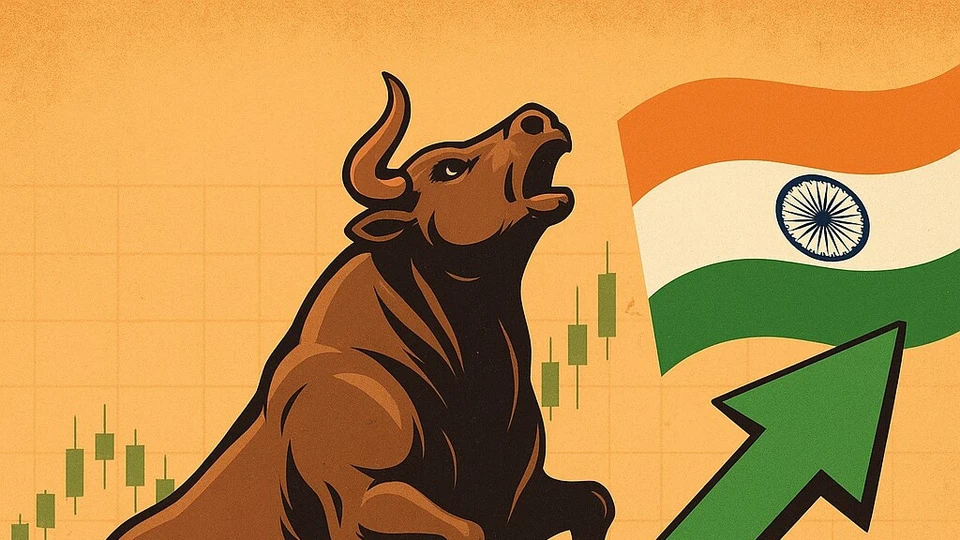Can the Sensex hit the 1,00,000 mark by the next Independence Day?
Given the prevailing headwinds – including Trump’s tariffs, foreign capital outflows, and weak earnings – it makes little sense to expect lofty returns from the Indian stock market in the medium term.
The Sensex has gained just 1.4 per cent since the last Independence Day, on geopolitical tensions, foreign capital outflow and weak earnings.
On August 12, the Sensex settled at 80,235.59. To reach the 1 lakh mark by the next Independence Day, the index would need to rise about 25 per cent over the next year.
This could be a daunting task for the bulls, but, as they say, the market has a habit of throwing surprises.
Meanwhile, Morgan Stanley believes the Sensex can hit the magical 1 lakh-mark by June 2026 in a bull case.
The global financial firm sees a 30 per cent probability of the Sensex hitting the 1 lakh mark by June 2026 on lower crude oil prices, prospects of an end to the global trade war, and government reforms.
“Oil prices are persistently below $65, resulting in better terms of trade and prompting more rate cuts from the RBI. The global trade war is curtailed by complete reversals in positions on tariffs, leading to improved growth prospects. Government reforms surprise to the upside with a slew of GST rate cuts and some progress on farm laws. Earnings growth compounds at 19 per cent annually over F2025-28,” Morgan Stanley observed in a note on August 4.
Let’s examine five key factors that, according to experts, could drive the index to the coveted 1,00,000 mark by the next Independence Day.
Five key factors can drive the Sensex to the 1 lakh mark
1. Solid earnings growth
The biggest challenge keeping the domestic market under pressure over the last year is India Inc.’s unimpressive earnings.
Major sectors like IT and banks posted lacklustre results, failing to sustain the market’s stretched valuations.
Experts say a solid earnings growth in the second half of the financial year will be crucial for the bulls to regain control and propel the benchmarks to record highs.
2. Government reforms
The Trump tariff saga has highlighted the urgent need for bold government reforms that can revive investors’ interest in the “India growth story”.
A strong focus on infrastructure and manufacturing projects, measures to boost domestic demand, free trade agreements (FTAs) with major trading partners, and perhaps a tweak in the LTCG tax may charge up the bulls.
3. No major geopolitical headwinds
Even though domestic factors dominate the Indian economy, the country cannot remain immune to geopolitical developments.
The end of the Russia-Ukraine war, a stable situation in the Middle East and a favourable tariff regime will augur well for the Indian economy and the stock market.
4. Strong foreign capital inflow
Over the last few years, especially in the post-pandemic world, retail investors’ clout has grown in the Indian stock market.
Nevertheless, foreign institutional investors (FIIs) remain a formidable force in the domestic market.
FPIs have been on a selling spree of Indian stocks since July, which has kept the market down.
The return of FPIs to the Indian market, along with continuous strong inflow of domestic retail investors, will boost the market to unprecedented levels.
5. Favourable growth-inflation dynamics
The Reserve Bank of India expects India’s growth-inflation dynamics to remain favourable in FY26 despite persisting uncertainty over the Trump tariffs and global factors.
After the August policy meeting, the RBI maintained India’s real GDP growth for FY26 at 6.5 per cent. Besides, the central bank cut the FY26 CPI inflation forecast to 3.1 per cent from 3.7 per cent earlier.
A favourable macroeconomic backdrop will augur well for corporate profitability, attract foreign capital inflow, and keep market sentiment positive.
It must be noted that the market would need a confluence of these factors to clock a robust gain of about 25 per cent in one year.
A lot will depend on how Trump’s tariff episode pans out, what measures the government takes to infuse fresh momentum in the economy and the movement of the US dollar and bond yields.
